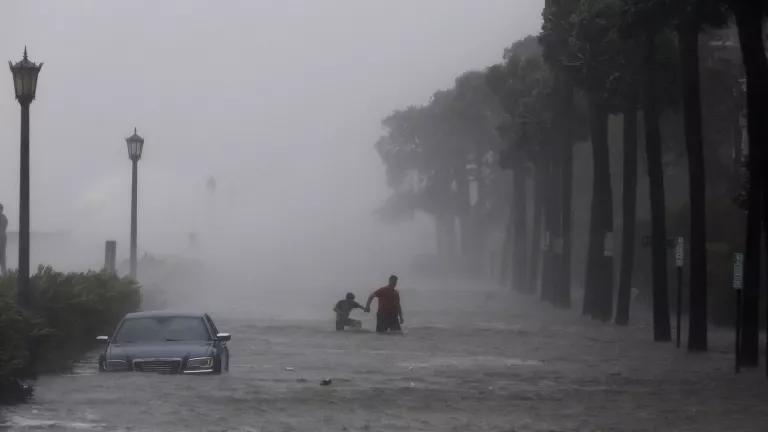IPCC Report: Sea Level Rise Is a Present and Future Danger
Sea level rise is going to be a growing problem for decades and centuries to come, no matter what emissions scenario we ultimately follow.

Sea levels are rising and will continue to rise for centuries to come according to the IPCC's Special Report on the Ocean and Cryosphere in a Changing Climate.
The latest report from the United Nation’s Intergovernmental Panel on Climate Change (IPCC) paints a very sobering picture of the challenges we face due to sea level rise. The Special Report on the Ocean and Cryosphere in a Changing Climate (SROCC) finds that global mean sea levels will most likely rise between 0.95 feet (0.29m) and 3.61 feet (1.1m) by the end of this century. These are the most dire sea level rise projections ever made by the IPCC.
As alarming as it is to think about sea levels that could be 3.61 feet (1.1m) higher by the end of this century, the IPCC projections are still somewhat conservative and do not include the full range of scenarios scientists think are possible.
Dr. Michael Oppenheimer, a lead author of the SROCC chapter on sea level rise, said in a recent article he co-authored for Scientific American that “climate skeptics and deniers have often accused scientists of exaggerating the threat of climate change, but the evidence shows that not only have they not exaggerated, they have underestimated.” That could very well be true of the SROCC and previous IPCC sea level rise projections.
Sea levels will rise under all emissions scenarios for centuries to come and accelerate in the second half of this century. Sea levels have already risen about a foot in the past several decades and communities all along the East and Gulf coasts of the U.S. are already experiencing chronic tidal flooding. Coastal communities are facing the threat of direct inundation as well as greatly magnified risks from storm surge, tidal flooding, extreme rain, and other effects of climate change.
NRDC has been working on a suite of solutions that can help the nation better prepare for and adapt to the reality of sea level rise.
- Climate smart reforms to the National Flood Insurance Program that include helping people move to higher ground, increased transparency and disclosure of flood risks, and producing flood maps that reflect future conditions and climate change.
- Making voluntary buyouts of flooded homes easier for people to secure, which allows them to move somewhere safer. This assistance needs to be made more widely available, more equitable, and more timely.
- Pushing for federal flood protection standards to ensure that public buildings and infrastructure are built with an additional margin of safety for flooding and consideration of future sea level rise.
These are hardly the only solutions communities, states, and the federal government need to pursue and only focus on the built environment. Sea level rise is a complex issue with multidimensional impacts. The projections themselves depend on a huge number of factors. The number of people who will be affected in the future depends on development decisions we cannot reliably forecast. The potential strategies for addressing these challenges are similarly complex and multidimensional.
What the IPCC projections do (and don’t) tell us about sea level rise
It’s important to realize that the IPCC SROCC projections reflect the scenarios that are most likely; not the full range of scenarios scientists think are possible.
The SROCC’s projections don’t fully account for the possibility of rapid changes in polar regions. But it’s become apparent that much higher levels of sea level rise are plausible because Greenland is melting much faster and there is increased instability in the West Antarctic. Both of these were once thought to be future worries, but that’s no longer an assumption we should rely upon.
These scenarios were better reflected in 2017 sea level rise projections made by the National Oceanic and Atmospheric Administration (NOAA), which informed the United States’ own National Climate Assessment. NOAA estimates that sea levels would likely rise between 1 foot (0.3m) and 4.27 feet (1.3m); higher than the IPCC’s SROCC projections. The National Climate Assessment pointed out that, “These ranges do not, however, capture the full range of physically plausible global average sea level rise over the 21st century,” and that sea levels could rise as much as 8.2 feet (2.5m) by the end of the century if rapid loss of Antarctic ice occurred.

The colored lines show different sea level rise scenarios. The boxes are the very likely ranges while the lines above the boxes show increases based on latest research on Antarctic.
A recent paper in the Proceedings of the National Academy of Sciences (co-authored by Dr. Oppenheimer, who is a lead author on the SROCC) recognized that sea level rise in excess of 6.56 feet (2.0m) is possible even if we successfully limit warming to only 2°C by the end of this century. While such an outcome is considered extremely unlikely, it wasn’t long ago that such an outcome was considered so implausible as to be beyond consideration.
Depending on where you are, sea levels could rise much higher
Sea level rise projections are given in terms of “global mean sea level” rise, or GMSL. This is the amount of sea level rise averaged over every point on the planet’s oceans. But sea levels at any given point vary depending on ocean currents and several other factors, including the gravitational pull of the ice in Greenland and Antarctica (or the lack thereof, if it’s melting). The amount of sea level rise in a specific location could vary about 30 percent from the global mean.
For the United States, NOAA projects that sea levels along the East Coast could be 0.4m–0.7m higher than GMSL, 0.2m–1.0m higher along the Gulf Coast, 0.2–0.3m higher along the West Coast, 0.3m–0.5m higher in Hawaii and Pacific Islands, and as much as 1.0m lower in Alaska.
Direct inundation is just part of the problem
When sea levels rise, it’s not just those below the new high tide line that have to worry. Rising seas means higher potential for flood events of all kinds. Tidal flooding, storm surge, and other forms of flooding in low-lying coastal areas become even more likely; what the IPCC calls “extreme sea level” events. In fact, the SROCC finds that, “In the absence of adaptation, more intense and frequent extreme sea level events, together with trends in coastal development will increase expected annual flood damages by 2-3 orders of magnitude by 2100.”
Flooding is just one of the challenges the world is already facing and that more areas will face in the future as sea levels rise.
Erosion of beaches and coastal lands, salinization of soils and farmlands , and saltwater intrusion into aquifers used for drinking water are all problems we’re starting to see and will grow in the future. Natural systems may not be able to keep up with the rapid rates of sea level rise now being projected. The salinity of freshwater rivers and wetlands may increase. Tidal wetlands and mangroves, which have some ability to migrate in response to rising seas, may find they have nowhere to migrate to because of human development that hems them in.
If sea level rise cannot be stopped, what can be done about it?
Sea level rise is not a reversible effect of climate change. Sea level rise does not stop in the year 2100. It’s just that we usually only talk about the projections out to that time frame. The SROCC makes it clear that, even under the most optimistic emissions reduction scenarios, the world will experience rising sea levels for several centuries to come. Coastal areas and island nations will have to consider a wide range of adaptation strategies, including migration or managed retreat.
The SROCC lays out the main strategies that are available to communities and nations.

Strategies include doing nothing, Protect (seawalls, levees, etc.), Accomodate (elevating structures or insurance), Advance (building a buffer out into the ocean), Retreat (moving away from the coast), and Ecosystem-based Adaptation.
All of these climate adaptation strategies suffer from one current flaw: We typically don’t take action on them until after a major coastal disaster has already happened.
The strategies of Protect, Accommodate, and Advance have some serious limitations, especially as sea levels approach or exceed those upper limits in the SROCC. First, these strategies are not very flexible—they hinge on correctly guessing how much the risk of flooding will increase. Structural approaches like seawalls and levees not only cost a lot to build, but can cost even more to maintain and operate. These solutions also tend to be one-dimensional, protecting against a single mode of vulnerability. A seawall may be effective against storm surge or direct inundation, but if groundwater rises behind that barrier or rainfall collects there, flooding will still occur.
On the other hand, Retreat and Ecosystem-based Adaptation have some distinct advantages. Managed retreat is the only strategy that permanently eliminates the potential for future damages. It also affords the opportunity to also address legacy problems like social inequity and access to modern infrastructure and services. Retreat doesn’t just mean moving away from vulnerable coastlines. It can also mean moving towards a better place than the one people are leaving behind.
Ideally, these two strategies are best implemented together, in a complementary fashion. As we help people relocate to higher ground and un-build previously developed areas, we will create new land that can then be used for ecosystem-based strategies. This not only can address vulnerabilities to sea level rise, but also create new habitat for wildlife, improve local water quality, or enhance groundwater recharge. And communities can rethink where people live, where economic development should take place, and how roads, water, sewers, and other infrastructure can be improved and redesigned for the future.
There are certainly drawbacks to Retreat and Ecosystem-based Adaptation, starting with being the two strategies we have the least experience with, especially at the scale that sea level rise will require. They also raise the same questions common to all adaptation strategies with regards to who pays and who benefits, as well as who is and isn’t going to get government assistance to relocate.
All of these strategies (Protect, Accommodate, Advance, Retreat, and Ecosystem-based strategies…as well as doing nothing at all) will be employed as communities, states, and the federal government come to grips with the reality of sea level rise. What we need to do is start implementing them. Preferably well in advance of major coastal disasters occurring.




